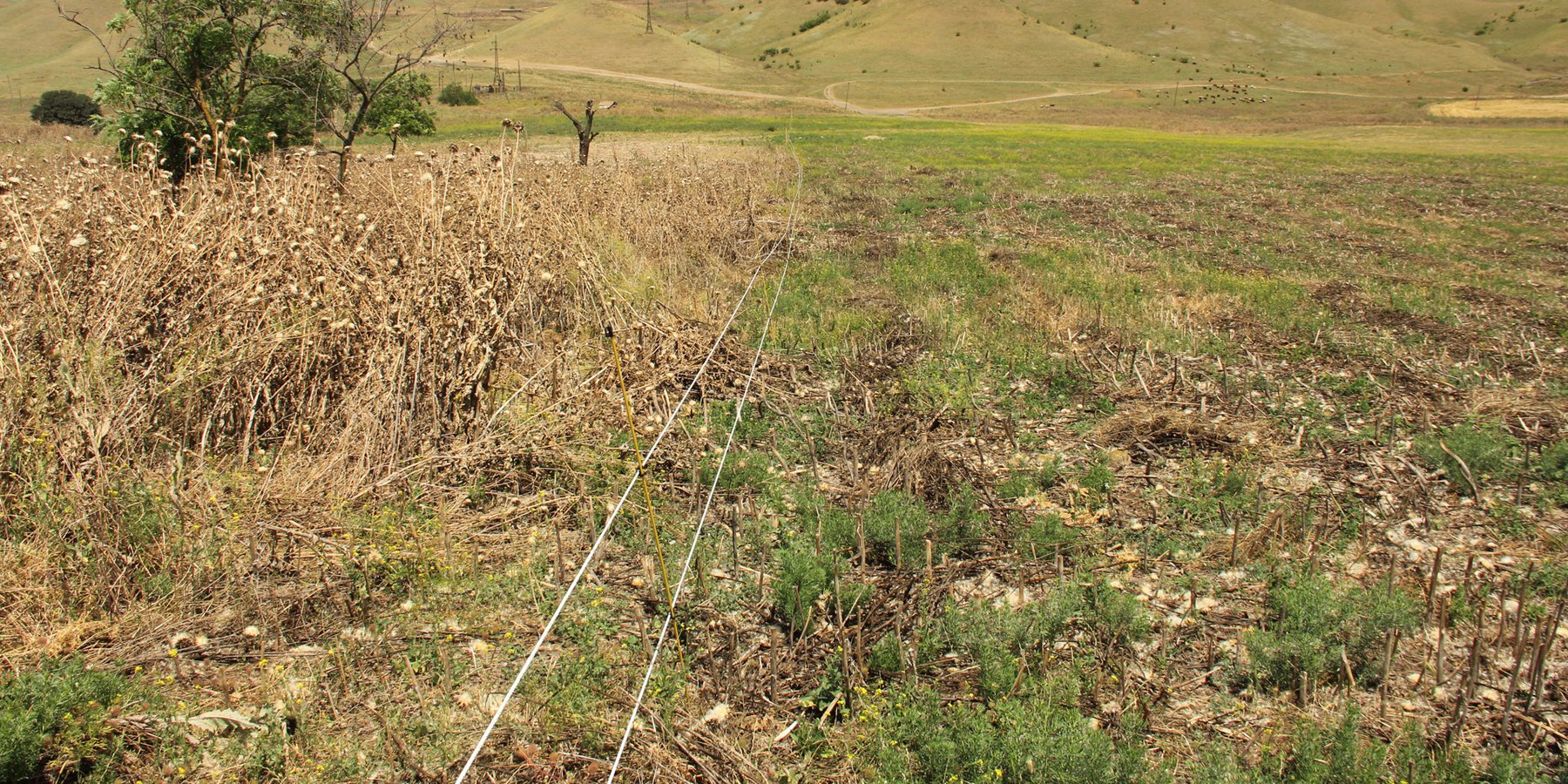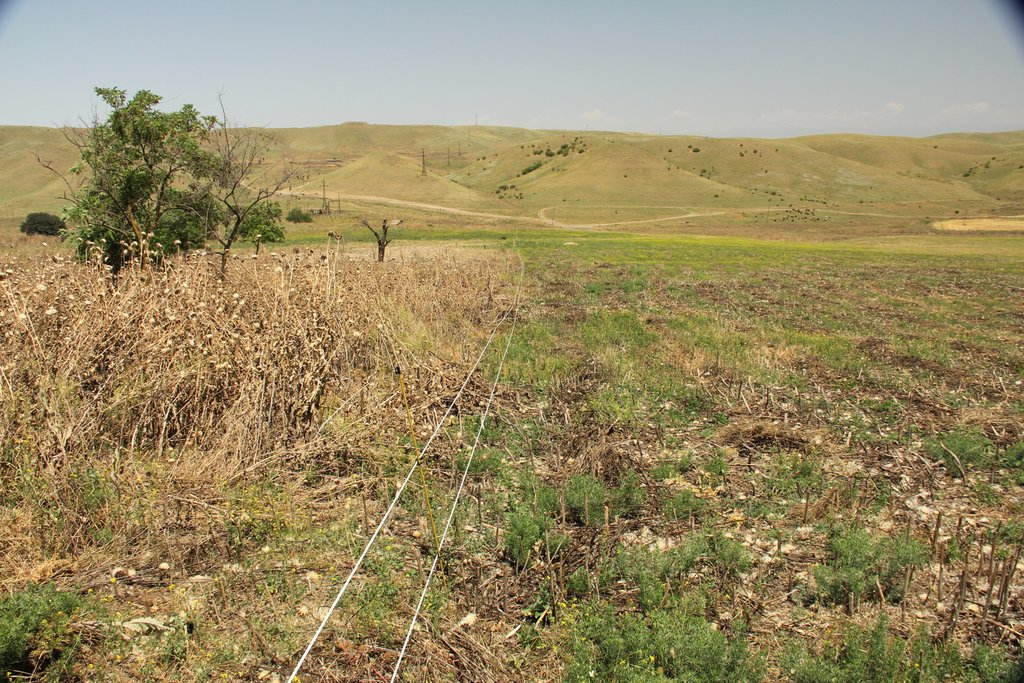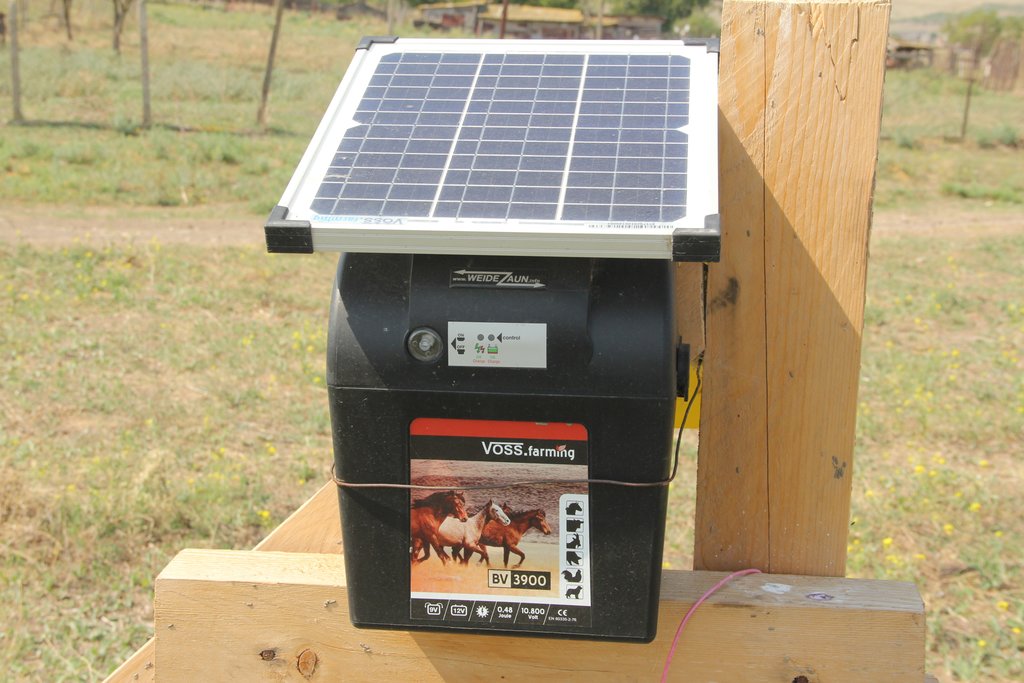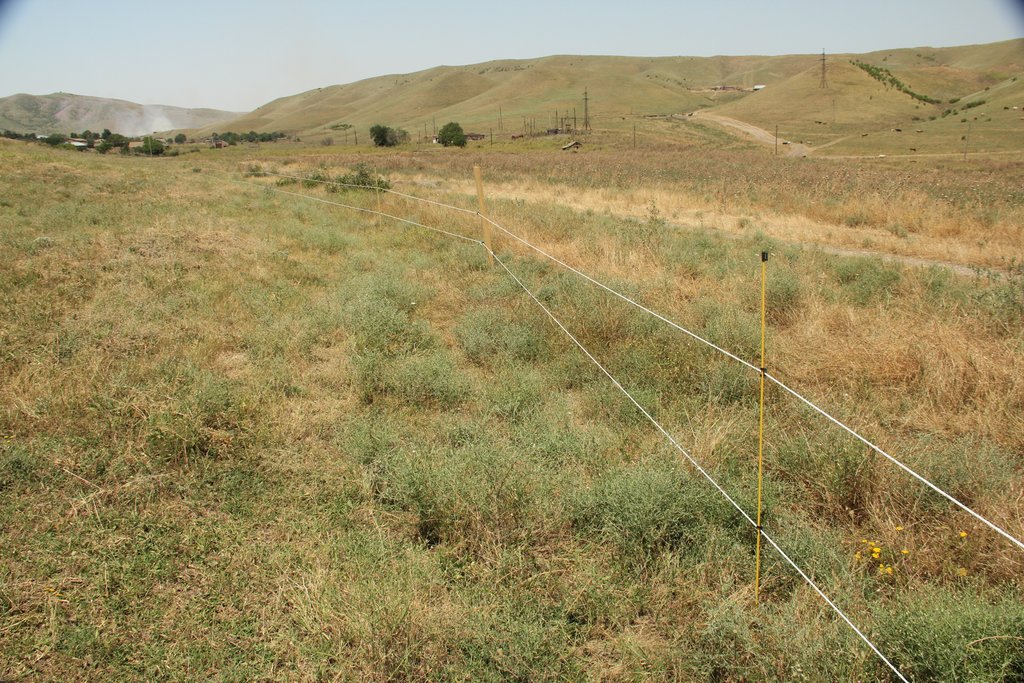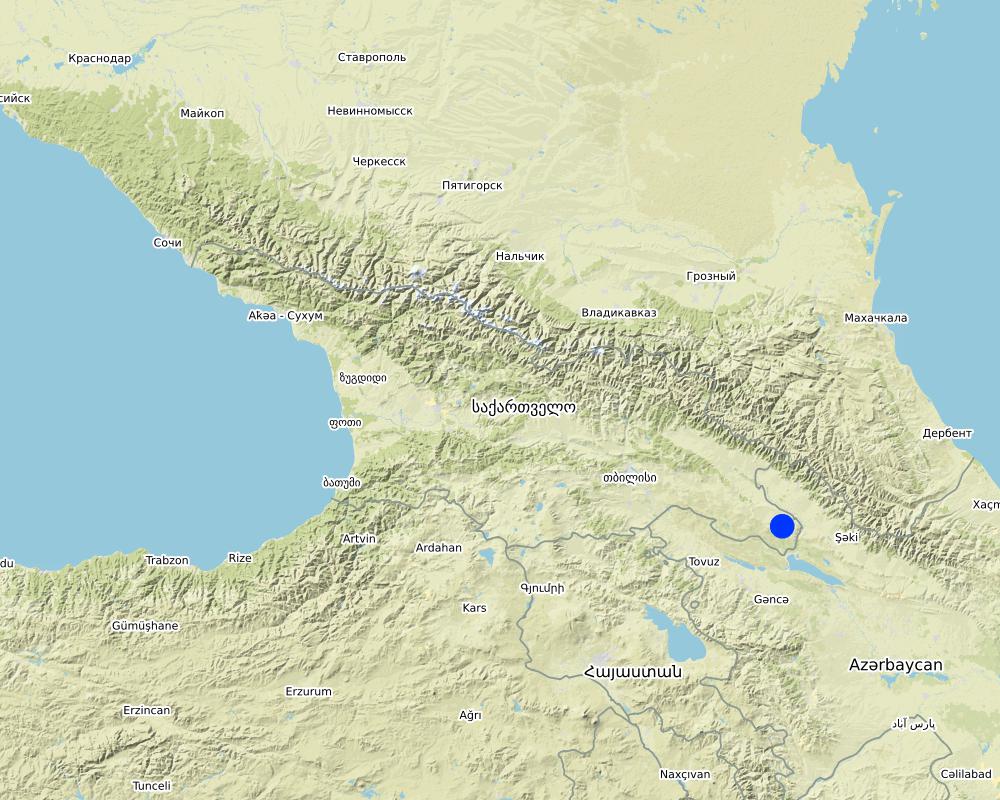Establishment of a paddock system and improvement of degraded pastureland. [Georgia]
- Creation:
- Update:
- Compiler: Hanns Kirchmeir
- Editor: Kety Tsereteli
- Reviewer: Rima Mekdaschi Studer
technologies_4276 - Georgia
View sections
Expand all Collapse all1. General information
1.2 Contact details of resource persons and institutions involved in the assessment and documentation of the Technology
Key resource person(s)
SLM specialist:
co-compiler:
1.3 Conditions regarding the use of data documented through WOCAT
The compiler and key resource person(s) accept the conditions regarding the use of data documented through WOCAT:
Yes
1.4 Declaration on sustainability of the described Technology
Is the Technology described here problematic with regard to land degradation, so that it cannot be declared a sustainable land management technology?
No
1.5 Reference to Questionnaire(s) on SLM Approaches (documented using WOCAT)
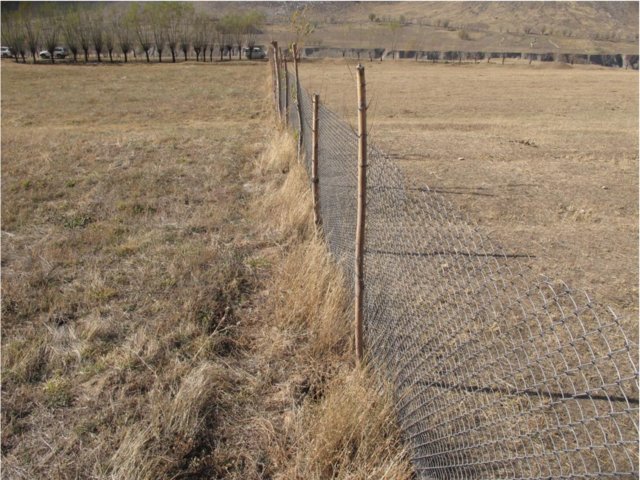
Rehabilitation of Pasture Land through fencing [Tajikistan]
The approach demonstrates the effect and importance of rotational grazing by fencing certain areas of land in pasture areas as well as it demonstrates the rehabilitation process in comparison to the open space which is overgrazed. The approach involves mobilizing communities to observe the rehabilitation process by not grasing in …
- Compiler: Askarsho Zevarshoev
2. Description of the SLM Technology
2.1 Short description of the Technology
Definition of the Technology:
In a pilot project, degraded pastureland near the settlement of Kasristskali was regenerated by introducing a fencing, mowing and grazing regime that favours the growth of forage plants instead of weeds and, where necessary, reseeding forage plants.
2.2 Detailed description of the Technology
Description:
This showcase is part of the project "Applying Landscape and Sustainable Land Management (L-SLM) for mitigating land degradation and contributing to poverty reduction in rural areas", implemented by the Regional Environmental Center for the Caucasus (REC C).
The implementation site was selected by national experts together with stakeholders from the village. This site is located close to the settlement Kasristskali. It is community pastureland, which was abandoned and not maintained for many years. The site had been dominated by thistles and weeds before the intervention took place and was not suitable for grazing. 30% of the area was previously used to store manure and is rich in nutrients. To reclaim the pastureland for cattle, an area of 6.1 ha was mowed twice and equipped with an electric fence (two lines of electric wire and a solar-powered energizer brand Voss). This was done to regenerate the area so that a grazing regime could be introduced later. An electric fence was chosen because wood is not available in the area and a wire mesh fence would be more expensive. Furthermore, an electric fence is flexibly adjustable, which is essential for a rotational grazing system. It is important to remove the residues after the mowing to reduce the amount of weed seed. The time of mowing should be before the flowering of the most common weed species. An ongoing mowing and grazing regime was set up to favour fodder plants instead of weeds: Since the cows only eat the fodder plants and leave the weeds standing, the weeds have a clear advantage. To counteract this, the weeds are mowed, and fodder plants are sown. Mowing is needed for the first 2 years and after that, it is enough to control the quality of pastureland by a grazing system. For maintenance purposes, the area was cut once in early spring and a second time in summer. The evaluation in September, after the pastureland was recultivated, showed that the northern and eastern parts now have a grass and herb cover suitable for grazing, while the central, western and southern parts are still overgrown by weeds. This is due to the fact that these parts were very rich in nutrients from the very beginning and consisted exclusively of thistles. In order to improve the productivity of the site, it is recommended to cut the vegetation again in autumn, remove the residues, open the soil with a harrow and sow a pasture seed mixture adapted to the climatic conditions in February.
The local community farmers were involved in all activities. They were participated in development of local pasture management plan. The plan was approved by the community members and they are ready to follow the applied methodology and maintain the pastureland after the project completion. The farmers acknowledged the benefit from the proposed methodology and they invested to rehabilitate the additional area (6 ha) of pastureland with their own financial sources.
The 6.1 ha plot which was restored as pastureland with this technology is planned to be used as a paddock for alternating grazing between free-range and the paddock.
2.3 Photos of the Technology
2.5 Country/ region/ locations where the Technology has been applied and which are covered by this assessment
Country:
Georgia
Region/ State/ Province:
Kakheti
Further specification of location:
Municpalty of Akhmeta, Kasristskali village
Specify the spread of the Technology:
- applied at specific points/ concentrated on a small area
Is/are the technology site(s) located in a permanently protected area?
No
Comments:
The national park Vashlovani is nearby.
Map
×2.6 Date of implementation
Indicate year of implementation:
2018
2.7 Introduction of the Technology
Specify how the Technology was introduced:
- through projects/ external interventions
Comments (type of project, etc.):
Applying Landscape and Sustainable Land Management (L-SLM) for mitigating land degradation and contributing to poverty reduction in rural areas; GEF funded, implementation by the Regional Environmental Center for the Caucasus (REC).
3. Classification of the SLM Technology
3.1 Main purpose(s) of the Technology
- improve production
- reduce, prevent, restore land degradation
3.2 Current land use type(s) where the Technology is applied
Land use mixed within the same land unit:
No

Unproductive land
Specify:
The area east of the village is rich in nutrients but was not maintained. A dense weed layer of milk thistle (Silybum marianum) was established.
Comments:
The main income of the village comes from agriculture in the plains of Shiraki Valley and livestock breeding in the hilly land east of the plains.
3.3 Has land use changed due to the implementation of the Technology?
Has land use changed due to the implementation of the Technology?
- Yes (Please fill out the questions below with regard to the land use before implementation of the Technology)
Land use mixed within the same land unit:
No

Grazing land
Intensive grazing/ fodder production:
- Improved pastures
Animal type:
- cattle - dairy
- cattle - non-dairy beef
Is integrated crop-livestock management practiced?
No
Products and services:
- meat
- milk
Species:
cattle - dairy and beef (e.g. zebu)
Comments:
The 6.1 ha plot which was restored as pastureland with this technology is planned to be used as a paddock for alternating grazing between free range and the paddock.
3.4 Water supply
Water supply for the land on which the Technology is applied:
- rainfed
3.5 SLM group to which the Technology belongs
- area closure (stop use, support restoration)
- pastoralism and grazing land management
3.6 SLM measures comprising the Technology

agronomic measures
- A7: Others

vegetative measures
- V2: Grasses and perennial herbaceous plants
- V4: Replacement or removal of alien/ invasive species

management measures
- M2: Change of management/ intensity level
- M5: Control/ change of species composition
- M7: Others
Comments:
The technology enables efficient weed control on common pasture land. The improvement of degraded pastures is achieved through weed control and sowing of fodder crops and the use of a rotational grazing system.
3.7 Main types of land degradation addressed by the Technology

biological degradation
- Bs: quality and species composition/ diversity decline
- Bp: increase of pests/ diseases, loss of predators
Comments:
The degradation is driven by excessive spread of milk-thistles on nutrient rich pasture land because of missing maintenance. Those thistle stand are of low plant diversity and have no fodder value.
3.8 Prevention, reduction, or restoration of land degradation
Specify the goal of the Technology with regard to land degradation:
- restore/ rehabilitate severely degraded land
Comments:
The technology supports the restoration of the weed dominated pasture land. This will increase biodiversity and productivity.
4. Technical specifications, implementation activities, inputs, and costs
4.1 Technical drawing of the Technology
Technical specifications (related to technical drawing):
The area on which the technology is applied is 6.1 ha. The paddock is on community rangeland and managed by the village people. It is located on a slightly north-oriented slope near the village. The area was used to store manure. The high nutrition values led to the enormous growth of weeds, especially thistles.
Author:
Hanns Kirchmeir
Date:
22/03/2019
4.2 General information regarding the calculation of inputs and costs
Specify how costs and inputs were calculated:
- per Technology area
Indicate size and area unit:
ha
Specify currency used for cost calculations:
- USD
Indicate average wage cost of hired labour per day:
13 USD/day
4.3 Establishment activities
| Activity | Timing (season) | |
|---|---|---|
| 1. | First mowing of the site, clearing from thistles and removal of hay/residuals | Early spring (March) |
| 2. | Establishment of electric fence | June |
| 3. | Opening the soil with a harrow | February of following year |
| 4. | Seeding of fodder plants | February of following year |
Comments:
It is important to remove the residues after mowing to reduce the amount of weed seed. The time of mowing should be before the flowering of the most common weed species.
4.4 Costs and inputs needed for establishment
| Specify input | Unit | Quantity | Costs per Unit | Total costs per input | % of costs borne by land users | |
|---|---|---|---|---|---|---|
| Labour | Setup of fence | person-days | 2.0 | 13.0 | 26.0 | |
| Labour | Open the soil with a harrow | person-days | 1.0 | 13.0 | 13.0 | |
| Labour | Seeding of fodder plants | person-days | 1.0 | 13.0 | 13.0 | |
| Labour | Mowing (1st time) an manual removal of thistles | person-days | 18.0 | 13.0 | 234.0 | |
| Equipment | Equipment for 1200m electric fence including energizer | set | 1.0 | 2547.0 | 2547.0 | |
| Equipment | Machinery for mowing (rental) | days | 1.0 | 400.0 | 400.0 | |
| Equipment | Machinery for harrowing (rental) | days | 1.0 | 400.0 | 400.0 | |
| Plant material | Seeds (Onobrychis) | kg | 300.0 | 1.5 | 450.0 | |
| Total costs for establishment of the Technology | 4083.0 | |||||
| Total costs for establishment of the Technology in USD | 4083.0 | |||||
If land user bore less than 100% of costs, indicate who covered the remaining costs:
The equipment, renting cost of machines and labor was financed by the GEF SLM project.
Comments:
The local village is very poor and lacks of infrastructure and financial capabilities.
4.5 Maintenance/ recurrent activities
| Activity | Timing/ frequency | |
|---|---|---|
| 1. | Second mowing and removal of hay | July |
| 2. | Third mowing and removal of hay | September |
Comments:
The weed population is still very high. These are poisonous or spicy plant species which cannot be controlled by intensive grazing. To reduce the dominance of this weed, it is recommended to mow the entire area of 6.1 ha three times a year. The best time to mow is before the weed blossoms.
4.6 Costs and inputs needed for maintenance/ recurrent activities (per year)
| Specify input | Unit | Quantity | Costs per Unit | Total costs per input | % of costs borne by land users | |
|---|---|---|---|---|---|---|
| Labour | Mowing (2nd and 3rd time) | person-days | 2.0 | 13.0 | 26.0 | |
| Equipment | Machinery for mowing (rental) | days | 2.0 | 400.0 | 800.0 | |
| Total costs for maintenance of the Technology | 826.0 | |||||
| Total costs for maintenance of the Technology in USD | 826.0 | |||||
Comments:
The community is very poor so the costs for maintenance was covered by the project. After the difficult removal of the thistles, the second and third mowing was done only by machinery and has not needed that much man power than the first time.
4.7 Most important factors affecting the costs
Describe the most determinate factors affecting the costs:
The most important factor was the equipment for the electric fence. Electric fencing material is not common in Georgia and there are no relevant national suppliers.
5. Natural and human environment
5.1 Climate
Annual rainfall
- < 250 mm
- 251-500 mm
- 501-750 mm
- 751-1,000 mm
- 1,001-1,500 mm
- 1,501-2,000 mm
- 2,001-3,000 mm
- 3,001-4,000 mm
- > 4,000 mm
Specify average annual rainfall (if known), in mm:
697.00
Specifications/ comments on rainfall:
The driest month is January, with 25 mm of rainfall. The greatest amount of precipitation occurs in June, with an average of 108 mm. The difference in precipitation between the driest month and the wettest month is 83 mm.
Indicate the name of the reference meteorological station considered:
Dedoplistskaro Met. Station
Agro-climatic zone
- semi-arid
The climate is warm and temperate in Dedoplistskaro. The average annual temperature in Dedoplistskaro is 11.3 °C. The warmest month of the year is July, with an average temperature of 22.7 °C. The lowest average temperatures in the year occur in January, when it is around 0.1 °C.
5.2 Topography
Slopes on average:
- flat (0-2%)
- gentle (3-5%)
- moderate (6-10%)
- rolling (11-15%)
- hilly (16-30%)
- steep (31-60%)
- very steep (>60%)
Landforms:
- plateau/plains
- ridges
- mountain slopes
- hill slopes
- footslopes
- valley floors
Altitudinal zone:
- 0-100 m a.s.l.
- 101-500 m a.s.l.
- 501-1,000 m a.s.l.
- 1,001-1,500 m a.s.l.
- 1,501-2,000 m a.s.l.
- 2,001-2,500 m a.s.l.
- 2,501-3,000 m a.s.l.
- 3,001-4,000 m a.s.l.
- > 4,000 m a.s.l.
Indicate if the Technology is specifically applied in:
- not relevant
Comments and further specifications on topography:
The pasture is located on top of a small hill and its north-eastern slopes.
5.3 Soils
Soil depth on average:
- very shallow (0-20 cm)
- shallow (21-50 cm)
- moderately deep (51-80 cm)
- deep (81-120 cm)
- very deep (> 120 cm)
Soil texture (topsoil):
- fine/ heavy (clay)
Soil texture (> 20 cm below surface):
- fine/ heavy (clay)
Topsoil organic matter:
- high (>3%)
If available, attach full soil description or specify the available information, e.g. soil type, soil PH/ acidity, Cation Exchange Capacity, nitrogen, salinity etc.
30% of area was used of manure storage before and is rich on nutrients.
5.4 Water availability and quality
Ground water table:
5-50 m
Availability of surface water:
poor/ none
Water quality (untreated):
poor drinking water (treatment required)
Water quality refers to:
ground water
Is water salinity a problem?
No
Is flooding of the area occurring?
No
5.5 Biodiversity
Species diversity:
- low
Habitat diversity:
- low
Comments and further specifications on biodiversity:
Only a few weed species where dominating the area before the intervention.
5.6 Characteristics of land users applying the Technology
Sedentary or nomadic:
- Sedentary
Market orientation of production system:
- mixed (subsistence/ commercial)
Off-farm income:
- less than 10% of all income
Relative level of wealth:
- poor
Individuals or groups:
- individual/ household
Level of mechanization:
- mechanized/ motorized
Gender:
- men
Age of land users:
- middle-aged
Indicate other relevant characteristics of the land users:
The village is very remote. Driving distance to the municipality is about 1h on bad roads.
5.7 Average area of land used by land users applying the Technology
- < 0.5 ha
- 0.5-1 ha
- 1-2 ha
- 2-5 ha
- 5-15 ha
- 15-50 ha
- 50-100 ha
- 100-500 ha
- 500-1,000 ha
- 1,000-10,000 ha
- > 10,000 ha
Is this considered small-, medium- or large-scale (referring to local context)?
- small-scale
5.8 Land ownership, land use rights, and water use rights
Land ownership:
- communal/ village
Land use rights:
- open access (unorganized)
Water use rights:
- open access (unorganized)
Are land use rights based on a traditional legal system?
Yes
Specify:
Community pasture land.
5.9 Access to services and infrastructure
health:
- poor
- moderate
- good
education:
- poor
- moderate
- good
technical assistance:
- poor
- moderate
- good
employment (e.g. off-farm):
- poor
- moderate
- good
markets:
- poor
- moderate
- good
energy:
- poor
- moderate
- good
roads and transport:
- poor
- moderate
- good
drinking water and sanitation:
- poor
- moderate
- good
financial services:
- poor
- moderate
- good
6. Impacts and concluding statements
6.1 On-site impacts the Technology has shown
Socio-economic impacts
Production
fodder production
Quantity before SLM:
0
Quantity after SLM:
1-2 t/ha
Comments/ specify:
The fodder production will increase in the next few years as mowing and grazing affect weed control.
fodder quality
Comments/ specify:
The fodder production will increase within the next years when mowing and grazing shows effect in the decrease of weeds.
production area
Quantity before SLM:
0 ha
Quantity after SLM:
6 ha
Comments/ specify:
6 ha of degraded and unused pastureland have been recultivated.
Income and costs
expenses on agricultural inputs
Comments/ specify:
Community is equipped with electric fencing infrastructure (including training)
Specify assessment of on-site impacts (measurements):
Most of the area could not be used for cattle grazing due to the dominance of weeds. Based on biomass harvesting experiments in Tusheti, it is expected that at least 1-2 tons of fodder per hectare will be available on the pasture.
6.2 Off-site impacts the Technology has shown
Specify assessment of off-site impacts (measurements):
No significant effects are expected off-site
6.3 Exposure and sensitivity of the Technology to gradual climate change and climate-related extremes/ disasters (as perceived by land users)
Gradual climate change
Gradual climate change
| Season | increase or decrease | How does the Technology cope with it? | |
|---|---|---|---|
| seasonal rainfall | summer | decrease | moderately |
Comments:
When temperatures rise and precipitation decreases, productivity falls. If productivity is below 1t/ha, the investment in an electric fence will not pay off.
6.4 Cost-benefit analysis
How do the benefits compare with the establishment costs (from land users’ perspective)?
Short-term returns:
negative
Long-term returns:
positive
How do the benefits compare with the maintenance/ recurrent costs (from land users' perspective)?
Short-term returns:
slightly negative
Long-term returns:
positive
Comments:
In the first two years, the forage harvest will be low, while the costs for erecting the fence and maintenance by mowing will be high. In the long run, unproductive land will be productive again. On the 6 ha, 6 to 12 tons of biomass per year can be expected (depending on rainfall in spring and summer). This is equivalent to 500-1000 USD/year.
6.5 Adoption of the Technology
- single cases/ experimental
Of all those who have adopted the Technology, how many did so spontaneously, i.e. without receiving any material incentives/ payments?
- 0-10%
Comments:
There is strong interest to establish a second plot for rotational pasture systems of 20ha near by. The financial capacity of the village is to low to cover the investment of the fencing material.
6.6 Adaptation
Has the Technology been modified recently to adapt to changing conditions?
No
6.7 Strengths/ advantages/ opportunities of the Technology
| Strengths/ advantages/ opportunities in the land user’s view |
|---|
| improved pasture quality and new fencing technology introduced |
| raised production of fodder plants |
| pasture management plan is developed and local farmers are able to manage the pasture rotational system themselves. Also the farmers were trained in installation and maintenance of el-fence. |
| Strengths/ advantages/ opportunities in the compiler’s or other key resource person’s view |
|---|
| A fertile land near the village, which was unusable, was turned back into productive land. |
6.8 Weaknesses/ disadvantages/ risks of the Technology and ways of overcoming them
| Weaknesses/ disadvantages/ risks in the land user’s view | How can they be overcome? |
|---|---|
| The pasture land has already been severely degraded (mainly by weeds) and it will take time and more resources to restore it. | Small grants to support the rental of machines for mower maintenance (topping cuts). |
| Weaknesses/ disadvantages/ risks in the compiler’s or other key resource person’s view | How can they be overcome? |
|---|---|
| The investments for the fencing cannot be made by the villagers. | Long-term microloans with low interest rates. |
| Seed of local, climate-adapted forage plants is not available. | Establishment of local seed suppliers in cooperation with the agricultural extension service. |
7. References and links
7.1 Methods/ sources of information
- field visits, field surveys
2 field visits in 2018
- interviews with land users
two interviews with local land users and one training on rotational pasture management, hands on training on installing and maintaining electric fence.
- interviews with SLM specialists/ experts
Discussion with national field experts
When were the data compiled (in the field)?
12/09/2018
7.2 References to available publications
Title, author, year, ISBN:
Applying Landscape and Sustainable Land Management (L-SLM) for mitigating land degradation and contributing to poverty reduction in rural areas: Final report. 2017. Kirchmeir, H., Joseph, A., Huber, M
Available from where? Costs?
RECC Caucasus
Links and modules
Expand all Collapse allLinks

Rehabilitation of Pasture Land through fencing [Tajikistan]
The approach demonstrates the effect and importance of rotational grazing by fencing certain areas of land in pasture areas as well as it demonstrates the rehabilitation process in comparison to the open space which is overgrazed. The approach involves mobilizing communities to observe the rehabilitation process by not grasing in …
- Compiler: Askarsho Zevarshoev
Modules
No modules


